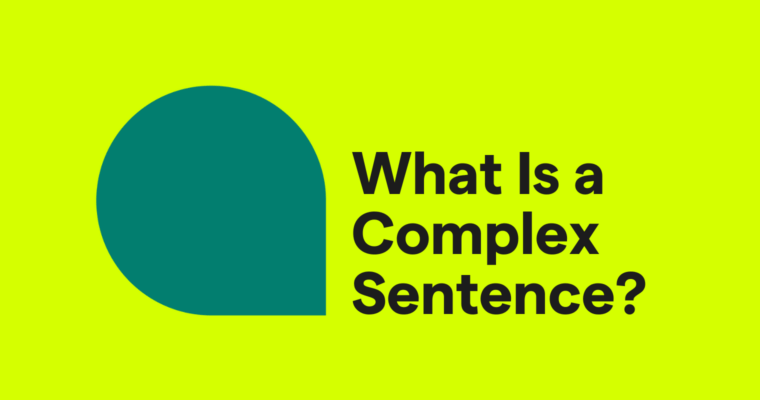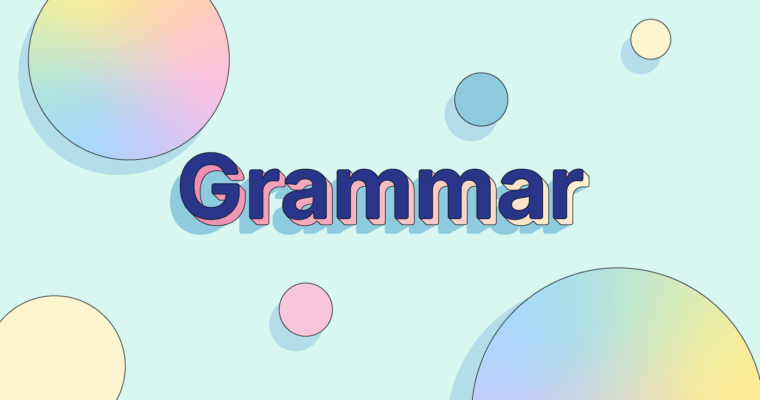
Key takeaways:
- A complex sentence contains one independent clause and at least one dependent clause.
- Complex sentences help provide more information on the main point.
- A complex sentence shows the relationship between two or more ideas more effectively than a simple sentence.
A complex sentence provides more information on your main point by joining one independent clause with at least one dependent clause. Complex sentences allow writers to provide more detail and background information in speech or writing.
For example, the complex sentence “Because the rain was heavy, the game was canceled” showcases the relationship between the independent clause that can stand on its own (the game was canceled) and the dependent clause that cannot stand alone (because the rain was heavy).
It’s key for writers to understand this concept in order to use different sentence types effectively for clear and thorough writing. Complex sentences add sophistication to your writing and allow you to convey nuanced, related ideas. They can also help you connect ideas logically and create a smoother flow compared with only using short, simple sentences.
Learn more about how to create, use, and identify complex sentences for engaging writing.
Table of contents
Difference between complex and simple sentences
Strategies to use complex sentences effectively
Common errors in complex sentences and how to fix them
Complex sentence structure
The structure of a complex sentence involves the connection of at least one dependent clause to an independent clause. An independent clause stands alone as a complete thought and is considered a simple sentence. Dependent clauses can’t stand alone and depend on independent clauses to provide meaning.
For example:
- Independent clause: She ran on the beach.
- Dependent clause: Although she’s tired.
- When combined to create a complex sentence: Although she’s tired, she ran on the beach.
Dependent clauses are crucial to the formula of a complex sentence. Although dependent clauses cannot stand alone, they enrich complex sentences by adding layers of information, context, and detail.
Complex sentence punctuation
Placing a dependent clause also influences punctuation, specifically when using commas in complex sentences. Generally, if the dependent clause comes before the independent clause, a comma separates the two clauses. However, a comma is typically unnecessary if the dependent clause comes after the independent clause. Still, there are some exceptions or stylistic choices where a comma should be used, especially with a short dependent clause at the end of a sentence.
Using subordinating conjunctions in complex sentences
Dependent clauses in complex sentences are also usually introduced by using subordinating conjunctions to provide context for how the dependent and independent clauses relate to one another. Common uses and examples of subordinating conjunctions include:
| Common usage | Subordinating conjunction examples | How it’s used in a complex sentence |
| Time | when, while, before, after, as, as soon as, since, until, once, whenever, now that, as long as, by the time | We need to finalize the travel plans by the time Sarah returns from her vacation. |
| Cause/effect | because, since, as, so that, in order that, as long as, inasmuch as | He spoke slowly and clearly so that everyone could understand his instructions. |
| Contrast/opposition | although, though, even though, whereas, while | Although the restaurant was crowded, the service was surprisingly fast. |
| Condition | if, unless, only if, even if, in case, provided that, as long as, supposing that | The team will make the playoffs only if they win their remaining two games. |
| Reason | because, since, as, inasmuch as | Since it was a holiday, all the banks were closed. |
| Place | where, wherever, whereas | The scientists conducted their research in a remote laboratory where the conditions were carefully controlled. |
| Manner | as if, as though, as | The child clutched the teddy bear as though it were the most precious thing in the world. |
What is the difference between complex and simple sentences?
Deciding whether to use complex or simple sentences depends on the desired effect you’re hoping to convey in your writing.
- Complex sentences allow you to express more details about the relationship between ideas and add depth and nuance to writing.
- Simple sentences provide clarity and conciseness to writing, making them perfect to help emphasize key points.

Understanding the difference between complex and simple sentences gives you the fundamental building blocks of writing clear and engaging sentences.
| Sentence Type | Components | Reason |
| Complex Sentence |
One independent clause; at least one dependent clause |
Add more information to the main idea, and provide more flow to sentences and paragraphs. |
| Simple Sentence | One independent clause | Share a complete thought. However, including multiple simple sentences in a row can make your writing feel choppy. |
Conditional sentences
As a note, conditional sentences that often express an “if/then” type of relationship utilize the complex sentence structure. To transform the example in the above graphic into a conditional sentence, it would read: “If it starts raining, we’re staying inside.”
Writers who effectively vary their sentence structure weave both complex and simple sentences throughout their writing to create an engaging rhythm to keep readers interested.
Uses of complex sentences
Understanding the uses of complex sentences will help you write better sentences. For example, in formal writing such as academic papers or professional reports, you can use complex sentences to explain complicated relationships between ideas, present evidence, and build a logical argument.
Learn about the different uses of complex sentences below:
| Uses of complex sentences | Example | Why it works |
| Showing relationships between ideas (i.e., cause and effect, time, contrast) | Because the power went out unexpectedly, the entire neighborhood was plunged into darkness. | The dependent clause provides the reason for the event described in the independent clause, showing the cause-and-effect relationship. |
| Adding detail and context | The new research paper, which explores the impact of social media on adolescent mental health, has generated significant discussion among psychologists. | The dependent clause explains the new research paper by adding details about its focus and relevance. |
| Creating sentence variety and flow | She finally understood the intricate problem after she spent hours carefully reviewing the calculations. | By ending the sentence with the dependent clause, the main statement is resolved and explained. The structure helps vary the pacing. |
| Emphasizing ideas | Although the evidence was circumstantial, the jury ultimately reached a guilty verdict. | The main point of this sentence is the jury’s verdict, which is the independent clause. The dependent clause emphasizes the idea while still highlighting the final decision. |
| Expressing conditional or hypothetical situations | The project will be approved only if the budget is significantly reduced. | The dependent clause specifies the condition under which the action in the independent clause can occur. Only if emphasizes the exclusivity of this requirement. |
Strategies to use complex sentences effectively
Thoughtfully created complex sentences are more effective for weaving information together and adding detail, depth, context, and emphasis.
Here are ways you can use complex sentences effectively:
- Vary sentence openings: To add variety to your writing, try starting some sentences with a dependent clause instead of consistently beginning with the subject and verb of an independent clause. This approach introduces the context or condition of your sentence first, which can gradually engage readers with the main idea.
- Choose the right subordinating conjunction: The subordinating conjunction you choose directly signals the relationship between the clauses. Select a conjunction that clearly and accurately connects your ideas to strengthen your argument. For example, using because indicates a cause-and-effect relationship: “Because the data was inconclusive, we needed to conduct further research.”
- Avoid overusing complex sentences: While complex sentences help add detail and sophistication to writing, relying too much on them can make your writing dense and difficult to follow. Aim for a balance of complex and simple sentences to prioritize clarity and flow.
- Ensure sentence clarity: Complex sentences aim to increase understanding, not complicate it. Make the relationship between the independent and dependent clauses clear and easily digestible, and avoid using obscure phrases or clauses that may confuse readers.
Complex sentence examples
Explore and understand some complex sentence examples, with the subordinating conjunction bolded for visibility, below:
| Complex sentence example | Type of relationship | Explanation |
| Because the rain was pouring down heavily, the outdoor market was canceled. | Cause and effect | Beginning with the subordinating conjunction because shows a cause-and-effect relationship between the independent and dependent clauses. |
| After the sun set below the horizon, the temperature began to drop noticeably. | Time | Beginning with the subordinating conjunction after indicates a time-based relationship between the independent and dependent clauses. |
| The speaker enunciated each word carefully so that the audience could easily understand his message. | Purpose | The dependent clause is introduced by the subordinating conjunction so that, indicating the purpose of the action in the main clause. |
| If you study diligently for the final exam, you will likely achieve a good grade. | Condition | Beginning with the subordinating conjunction if sets up a conditional relationship between the independent and dependent clauses. |
| He spoke about the experience as though he had witnessed the entire event firsthand. | Manner | Beginning with the subordinating conjunction as though describes how the subject in the independent clause spoke. |
Common errors in complex sentences and how to fix them
Even though complex sentences add depth and explanation to writing, they can also lead to critical grammatical errors. Constructing correct complex sentences involves understanding their components and being aware of common mistakes.
Here are some common errors to keep an eye out for when writing complex sentences and how to fix them:
Comma splice
This error occurs when only a comma joins two independent clauses together. While a comma can separate an independent clause from a dependent clause, it’s incorrect to link two complete thoughts on their own.
You can fix comma splice errors in this example sentence, “The rain stopped, the sun began to shine,” by:
| How to fix | Example |
| Replace the comma with a semicolon. | The rain stopped; the sun began to shine. |
| Add a coordinating conjunction after the comma. | The rain stopped, and the sun began to shine. |
| Transform one of the independent clauses into a dependent clause. | After the rain stopped, the sun began to shine. |
| Separate the clauses into two sentences. | The rain stopped. The sun began to shine. |
Run-on sentences
This error occurs when you join two or more independent clauses without any punctuation or connecting words. They can make your writing difficult to read and understand.
You can fix run-on sentence errors by:
| Fix | Example |
| Separating the clauses into multiple sentences | The cat looked out the window. It watched the birds flying around. Then it scratched at the window, trying to get the birds. |
| Joining the independent clauses with a comma and a coordinating conjunction | The cat looked out the window, and it watched the birds flying around. |
| Joining the independent clauses with a semicolon | The cat looked out the window; it watched the birds flying around. |
| Transforming one of the independent clauses into a dependent clause and adding a subordinating conjunction | While the cat looked out the window, it watched the birds flying around. |
Dangling modifier
This error contains a phrase or clause that doesn’t clearly and logically modify the word it’s intended to modify, often because the intended subject is missing or unclear in the main clause.
You can fix dangling modifier errors by:
| Fix | Example |
| Rewriting the sentence so the modifier is placed next to the correct word | Walking down the street, a beautiful mural was seen. |
| Rewriting the dangling modifier as a dependent clause with its own subject | While I was walking down the street, I saw a beautiful mural. |
Subject/verb agreement
In complex sentences, especially when a clause or phrase separates the subject and verb, it can be easy to make the verb disagree with its true subject. The verb must agree in number (singular or plural) with the main subject of the independent clause.
You can fix subject/verb agreement errors by:
- Identifying the main subject of the independent clause
- Ensuring the verb in the independent clause agrees in number with the subject
- Paying attention to subjects that are singular but might seem plural because they follow a prepositional phrase with a plural noun
Add detail to your writing with complex sentences
Vary your writing with a mix of complex and simple sentences to introduce flow to your structure. A complex sentence introduces details related to your subject. Whether you’re composing an academic essay or a business proposal, include complex sentences to increase understanding and keep readers engaged.
Use Grammarly to keep all sentences clear
Complex sentences add depth and sophistication to your writing, but they can also introduce grammar mistakes, unclear structure, or run-ons. Grammarly helps you navigate that complexity by flagging sentence structure issues, suggesting clearer phrasing, and ensuring your ideas stay connected and easy to follow. Reword sentences instantly with Grammarly’s AI sentence rewriter, which simplifies rephrasing and effortlessly transforms your text.
Complex sentence FAQs
Learn more about complex sentences and how you can include them below:
What is the rule for complex sentences?
The basic rule for complex sentences is that they must contain one independent clause and at least one dependent clause. Complex sentences make an independent clause rely on dependent clauses for more information and context.
What is a compound complex sentence?
A compound complex sentence is a sentence that combines the features of a complex and a compound sentence to share two complete ideas. They feature at least two independent clauses and at least one dependent clause.
For example, “Because the weather was so beautiful, we decided to go for a hike, and we packed a picnic to enjoy at the summit” is a compound complex sentence. This sentence contains two independent clauses (we decided to go for a hike and we packed a picnic to enjoy at the summit) and one dependent clause (because the weather was so beautiful).
What’s the best way to identify a complex sentence?
The best way to identify a complex sentence is to apply the rule of complex sentences:
- Identify the clauses that make up the sentence.
- Determine if there are both independent and dependent clauses present.
- Search for subordinating conjunctions that connect the clauses and help define their relationship.
How long should a complex sentence be?
There are no strict rules or guidelines on how long a complex sentence should be. A sentence’s ideal length is dependent on:
- Clarity: Is the sentence understandable? If a complex sentence is too long, it can interfere with the reader’s comprehension.
- Readability: Is the sentence digestible? Shorter sentences are easier to comprehend, but longer sentences provide detail. Aim for a mix.
- Complexity of ideas: Are the topics hard to understand? Complex topics can result in longer sentences to explain the context. Break down long sentences as needed for clarity.
- Audience: Who are you writing for? A general audience will benefit from more direct sentences, while a specialized audience understands more and will be more comfortable with intricate sentences.
- Purpose: What’s the point of the sentence? Making a simple statement lends itself to shorter sentences, while more detail often requires length.



